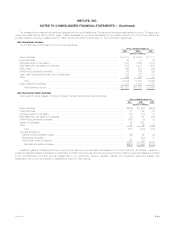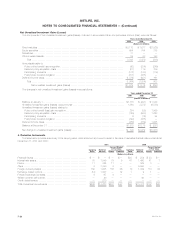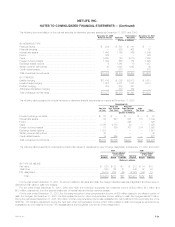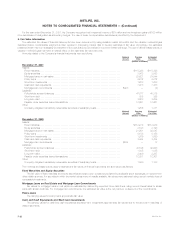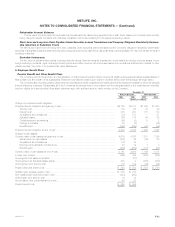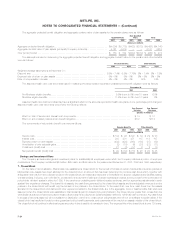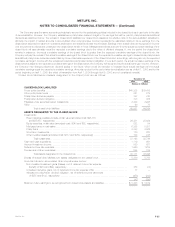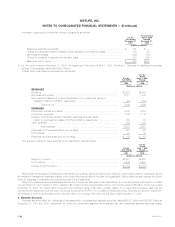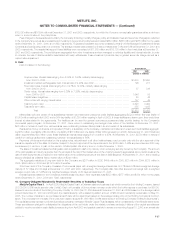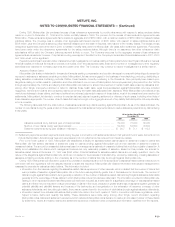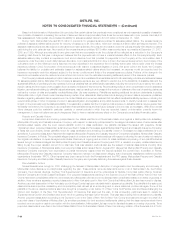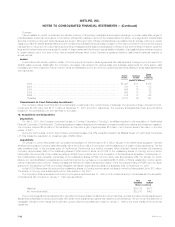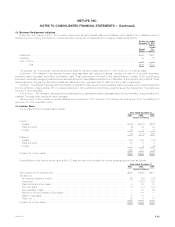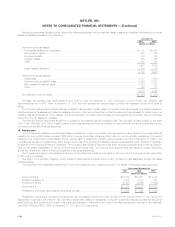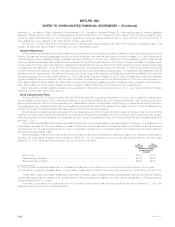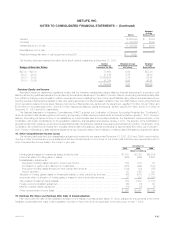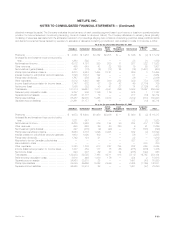MetLife 2001 Annual Report Download - page 68
Download and view the complete annual report
Please find page 68 of the 2001 MetLife annual report below. You can navigate through the pages in the report by either clicking on the pages listed below, or by using the keyword search tool below to find specific information within the annual report.
METLIFE, INC.
NOTES TO CONSOLIDATED FINANCIAL STATEMENTS — (Continued)
During 1998, Metropolitan Life purchased excess of loss reinsurance agreements to provide reinsurance with respect to sales practices claims
made on or prior to December 31, 1999 and for certain mortality losses in 1999. The premium for the excess of loss reinsurance agreements was
$529 million. These reinsurance agreements had a maximum aggregate limit of $650 million, with a maximum sublimit of $550 million for losses for sales
practices claims. The coverage was in excess of an aggregate self-insured retention of $385 million with respect to sales practices claims and
$506 million, plus the Company’s statutory policy reserves released upon the death of insureds, with respect to life mortality losses. The excess of loss
reinsurance agreements were amended in 2000 to transfer mortality risks under the Metropolitan Life class action settlement agreement. Recoveries
have been made under the reinsurance agreements for the sales practices claims. Although there is no assurance that other reinsurance claim
submissions will be paid, the Company believes payment is likely to occur. The Company accounts for the aggregate excess of loss reinsurance
agreements as reinsurance; however, if deposit accounting were applied, the effect on the Company’s consolidated financial statements in 2001, 2000
and 1999 would not be significant.
Regulatory authorities in a small number of states have had investigations or inquiries relating to Metropolitan Life’s, New England Mutual’s or General
American’s sales of individual life insurance policies or annuities. Over the past several years, these and a number of investigations by other regulatory
authorities were resolved for monetary payments and certain other relief. The Company may continue to resolve investigations in a similar manner.
Asbestos-Related Claims
Metropolitan Life is also a defendant in thousands of lawsuits seeking compensatory and punitive damages for personal injuries allegedly caused by
exposure to asbestos or asbestos-containing products. Metropolitan Life has never engaged in the business of manufacturing, producing, distributing or
selling asbestos or asbestos-containing products. Rather, these lawsuits, currently numbering in the thousands, have principally been based upon
allegations relating to certain research, publication and other activities of one or more of Metropolitan Life’s employees during the period from the 1920’s
through approximately the 1950’s and alleging that Metropolitan Life learned or should have learned of certain health risks posed by asbestos and,
among other things, improperly publicized or failed to disclose those health risks. Legal theories asserted against Metropolitan Life have included
negligence, intentional tort claims and conspiracy claims concerning the health risks associated with asbestos. While Metropolitan Life believes it has
meritorious defenses to these claims, and has not suffered any adverse judgments in respect of these claims, most of the cases have been resolved by
settlements. Metropolitan Life intends to continue to exercise its best judgment regarding settlement or defense of such cases, including when trials of
these cases are appropriate. The number of such cases that may be brought or the aggregate amount of any liability that Metropolitan Life may ultimately
incur is uncertain.
The following table sets forth the total number of asbestos personal injury claims pending against Metropolitan Life as of the dates indicated, the
number of new claims during the years ended on those dates and the total settlement payments made to resolve asbestos personal injury claims during
those years:
At or for the Years Ended
December 31,
2001 2000 1999
Asbestos personal injury claims at year end (approximate) ***************************** 89,000 73,000 60,000
Number of new claims during year (approximate) ************************************* 59,500 54,500 35,500
Settlement payments during year (dollars in millions)(1) ******************************** $ 90.7 $ 71.1 $ 113.3
(1) Settlement payments represent payments made during the year in connection with settlements made in that year and in prior years. Amounts do not
include Metropolitan Life’s attorneys’ fees and expenses and do not reflect amounts received from insurance carriers.
Prior to the fourth quarter of 1998, Metropolitan Life established a liability for asbestos-related claims based on settlement costs for claims that
Metropolitan Life had settled, estimates of settlement costs for claims pending against Metropolitan Life and an estimate of settlement costs for
unasserted claims. The amount for unasserted claims was based on management’s estimate of unasserted claims that would be probable of assertion. A
liability is not established for claims which management believes are only reasonably possible of assertion. Based on this process, the accrual for
asbestos-related claims at December 31, 1997 was $386 million. Potential liabilities for asbestos-related claims are not easily quantified, due to the
nature of the allegations against Metropolitan Life, which are not related to the business of manufacturing, producing, distributing or selling asbestos or
asbestos-containing products, adding to the uncertainty as to the number of claims that may be brought against Metropolitan Life.
During 1998, Metropolitan Life decided to pursue the purchase of excess insurance to limit its exposure to asbestos-related claims noted above. In
connection with the negotiations with the casualty insurers to obtain this insurance, Metropolitan Life obtained information that caused management to
reassess the accruals for asbestos-related claims. This information included:
)Information from the insurers regarding the asbestos-related claims experience of other insureds, which indicated that the number of claims that
were probable of assertion against Metropolitan Life in the future was significantly greater than it had assumed in its accruals. The number of
claims brought against Metropolitan Life is generally a reflection of the number of asbestos-related claims brought against asbestos defendants
generally and the percentage of those claims in which Metropolitan Life is included as a defendant. The information provided to Metropolitan Life
relating to other insureds indicated that Metropolitan Life had been included as a defendant for a significant percentage of total asbestos-related
claims and that it may be included in a larger percentage of claims in the future, because of greater awareness of asbestos litigation generally by
potential plaintiffs and plaintiffs’ lawyers and because of the bankruptcy and reorganization or the exhaustion of insurance coverage of other
asbestos defendants; and that, although volatile, there was an upward trend in the number of total claims brought against asbestos defendants.
)Information derived from actuarial calculations Metropolitan Life made in the fourth quarter of 1998 in connection with these negotiations, which
helped to frame, define and quantify this liability. These calculations were made using, among other things, current information regarding
Metropolitan Life’s claims and settlement experience (which reflected Metropolitan Life’s decision to resolve an increased number of these claims
by settlement), recent and historic claims and settlement experience of selected other companies and information obtained from the insurers.
MetLife, Inc. F-29


